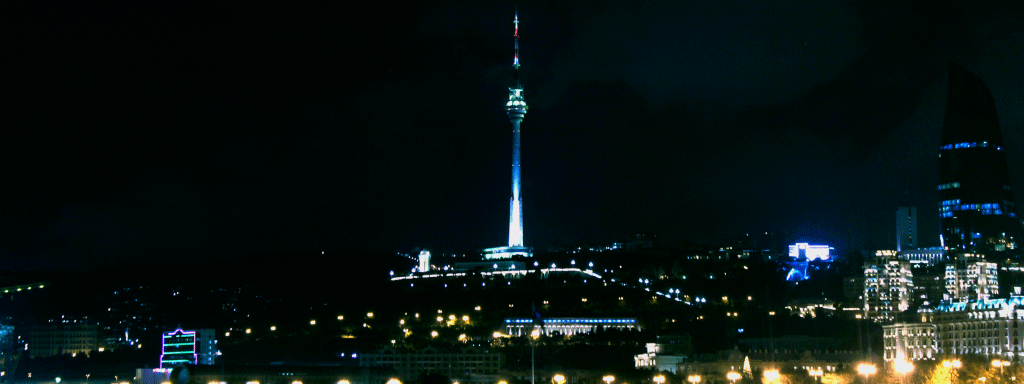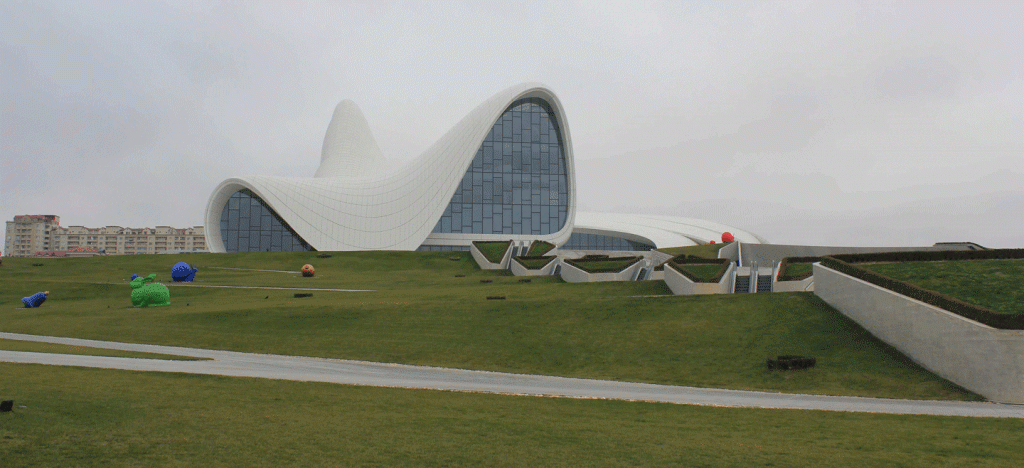
ARCHITECTURE
Architecture in Azerbaijan is a telling portrait of the countries rich and diverse history. Highlighting the trophies and keepsakes of the past compared to the fantastically contemporary and elegant present.
Ancient Architecture
Cave Paintings
The earliest proof of society within Azerbaijan include the illustrative cave paintings found in the Gubbastan mountains, outside of Baku. As such, today, the site is a UNESCO World Heritage Site.
Early Cave Shelters
There are also a number of examples of dwelling adaptations made to numerous caves in the foothills of the Major Caucasus and Minor Caucasus Mountains. These have all been given UNESCO World Heritage status for their historical and cultural significance.
Researchers have found more cave paintings in the Talysh Mountains, in Nakhicheva, in Zangilan, Kalbadjar, Gadabay, Khanlar, Shamaxi. This is in addition to the famous Azikh cave, which was discovered in the territory of the Fuzuli region.
Archaeologists have determined that people lived in these caves approximately 1.5 million years ago and believe that they tried to adapt the natural structure and benefits of the caves to their lifestyle.
As a result these caves show of the peoples’ innovation with the development of building tools. They drilled holes (flues) in the ceiling to guide fire smoke out of the cave, and also made special hollows into internal walls to keep their tools.
Artificial Caves
Ancient people eventually developed this cave-adaptation into the construction of well engineered artificial caves in more locations across Azerbaijan. The artificial caves were, similarly, built into sheer cliffs and at the foothills of the mountains, just as you would expect a natural caves to be situated.
They can be found in the south-eastern foothills of the Major Caucasus, in the Minor Caucasus, on the Bargushad and Akara banks in the Gubadli region, near the villages of Maraza, Sundi and Darakandi in the Shirvan region, as well as in the territories, which long ago belonged to the ancient states of Manna and Midia.
The ancient Azerbaijani people built these artificial caves at a certain height above ground level, probably for security reasons.
Mountainside Dwellings
The methods of artificial cave construction started changing after the invention of masonry. People now began to build new mud and half-mud huts. They continued to build them into into mountainsides and hillsides.
Since, the people did not yet have strong skills in upward engineering, buildings that spanned over two floors would contain an underground grotto as a lower part, while the upper part (the entrance) served as a porch of natural stones to protect them from heat and cold.
Scientists report that such buildings existed even before the state of Midiya and were widespread during the period of Midiya.
Traditional Architecture
Architecture in Azerbaijan typically combines elements of the Orient of the East, as well as treasures of Europe from the West.
Many ancient architectural treasures such as the medieval, Maiden Tower and Palace of the Shirvanshahs’ inside the UNESCO marked walled city of Iceriseher in Baku, survive and flourish. Modern Azerbaijan continues to value and utilize these great works.
Among other medieval architectural treasures, the country also boasts the Palace of Shaki Khans in the town of Shaki in north-central Azerbaijan, the Surakhany Temple on the Apsheron Peninsula, a number of impressive bridges spanning the Aras River, and several mausoleums.
19th and 20th Century Architecture
In the nineteenth and early twentieth centuries few monuments were erected in a similar fashion. However, distinctive residences were built in Baku and elsewhere.
Baku is also known for its early 1900’s architecture linked predominantly to the Democratic Republic of Azerbaijan, formed in 1918. This was also at the time of the great ‘Oil Boom’ in Azerbaijan. The companies being set up on the Caspian Sea during this time also built many of the new, lavish buildings as homes and offices.
Typically, these buildings were designed as large blocks, with decorative stone facades that can be likened to western Edwardian architecture. They sit in stark contrast beside the Medieval gems such as The Maiden Tower.
Contemporary Architecture
Azerbaijan has a heritage of championing architecture in different periods of history. In particular, over the past 20 years, the cities have embraced some stunning statement buildings. As a result, good architecture is for all in the minds of the Azerbaijani people.
In keeping with this philosophy, parallel to their famous architectural monuments, are the public sector’s subways in Baku. Undeniably, the subways stand out for their lavish decor and oppulance.
The State Committee for City Building and Architecture of Azerbaijan Republic regulates all urban planning and architectural activities in Azerbaijan.

Architecture To Note:
Baku TV Tower – Completed 1996
This tower is the tallest ‘structure’ in Azerbaijan. The Ministry of Communications of Azerbaijan State Institute of the Ministry of Communications of the USSR originally commissioned its design. Workers began construction in 1979 and the Ministry intended in completion in 1985.
Therefore, it was only after the return of Heydar Aliyev to power in 1993, the construction of the tower was continued. In 1996 with his participation, the official opening ceremony of the complex too place.
The telecommunications tower is 310m tall and made of concrete with a nod to a Brutalist era of architecture in Europe around the late 1960’s / 70’s. Additionally, a rotating restaurant on the 62nd floor ( at 175 metres) of the TV Tower was opened in 2008 and has quickly become one of Azerbaijan’s most famous eateries.
The Heydar Aliyev Centre – Completed 2003 – Architect – Zaha Hadid
The Heydar Aliyev Centre is a 619,000-square-foot building complex in Baku, Azerbaijan, designed by Iraqi-British architect Zaha Hadid. Hence, it is notable for its distinctive flowing lines and curved style that eschews sharp angles.
The centre is named after Heydar Aliyev, the leader of Soviet-era Azerbaijan from 1969 to 1982, and president of Azerbaijan from October 1993 to October 2003. It contains a museum dedicated to Aliyev and notably, contains some of the country’s jewels in presidential gifts. This cultural centre is also home to a revolution of contemporary museum exhibitions and art shows. Fans hail the building as one of the late Zaha Hadid’s greatest designs and it continues to draw a lot of international interest.
The Flame Towers – Completed 2012
The three towers are the tallest skyscrapers in Baku, due to their height of 190m. The buildings consist of luxury apartments, a hotel and an office block, which form today’s main architectural uses of modern Baku. These grand glass buildings have an estimated cost of approximately US $350 million and construction began in 2012 by HOK architects. The Flame Towers consist of three buildings; south, east and west. The facades of the three Towers turn into gigantic display screens with the use of more than 10,000 high-power LED luminaires every night, so every evening the city hosts an interactive light show. This light show has catalysed the evening scene of Baku which is now a city of light, which many buildings following suit and providing an array of light shows at dusk.

